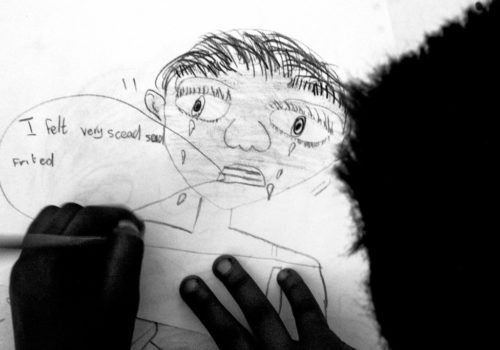The books opens with a blood-red warning to readers. Victims of sexual assault are asked not to read further without counseling. The page is red, like the notebook belonging to Dylan, the first victim we meet, who speaks with a disturbing coldness and explains in raw words how his life has been defined by sex, forced and consensual, since he was abused at age eight by a priest, whose contact information Dylan keeps carefully up to date in his little red notebook. From there it’s a horrific downward spiral, with a schoolteacher and the mother of a friend becoming the regular lovers of a 10-year old child, whose love is inextricably linked with hate in this immoral orgy. From one authority to another, from child prostitution in trains to servicing an exclusive clientele, it never stops. All sense of normalcy is turned upside down. The abused child becomes a prostitute, a drug addict and, finally, a killer. His story inspires this unbearable study by Mariella Furrer, to whom he wrote: “I would love to write a book. I would call it My Piece of Sky because when I was in prison I spent three-hundred-and-sixty-five days in isolation at one stage because I was quite a radical, naughty boy. I was lying in prison and all I had in my single cell was the window and I had my piece of sky, you see? And that, my piece of sky, was what I was thinking of, what I was going back to, reliving past events. I had all this time to myself, a whole year, three-hundred-and-sixty-five days without contact, and that was my piece of sky.”
Furrer replaces the conventional structure of a book— beginning, climax, conclusion—by starting out from the unbearable depths in the book’s first words and images: the death of a 6-year old child, drugged to shoot child pornography, and a photograph of blood-soaked panties with the caption, “Bloody underwear of a rape victim, age 3.” Each page from there pushes the boundaries.
Furrer admits in the introduction that she often wished to abandon the project, to escape its intolerable stories. The reader is also tempted to close this nearly 700-page tome, almost as thick as it is wide, bludgeoned by its violence. We forge on, however, with clenched throats, to understand the complex subject Furrer has explored to its darkest depths. Professor Bruce D. Perry called this ten-year study, “an astounding work of transforming evidence.”
Transforming—it’s the least we can say to describe the exhausted state in which the books leaves us, after reading the accounts of victims, rapists, families, doctors, transcripts from interrogations and children’s drawings whose distorted black-hatched mouths seems to cry out into the void. From this piece of sky, love has fled like birds in search of calm. In the background looms a society where any attempt to protest or curb the violence seems pathetic. How powerless the mothers look crying out in capital letters, “STOP RAPING AND KILLING OUR CHILDREN.” How useless the ten death sentences seem when their victims cannot be brought back to life. Mariella Furrer does not condemn the sexual abuse of children, but instead reveals the perversity of the consequences by juxtaposing normal life alongside the horrors, something that photography alone can convey.
BOOK
My Piece of Sky, Mariella Furrer
Bruce D. Perry, M.D., Ph.D.
Senior Fellow, The Child Trauma Academy Houston, Texas
676 pages, 36 dollars
















